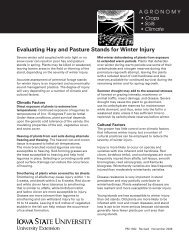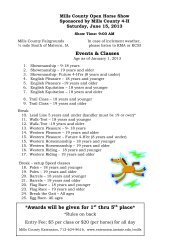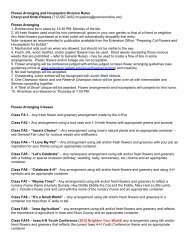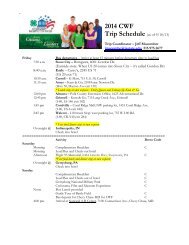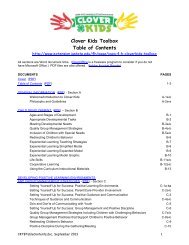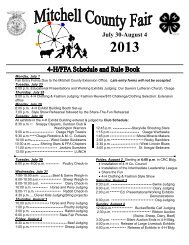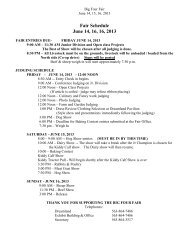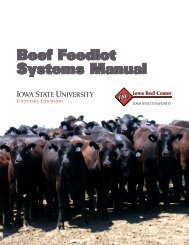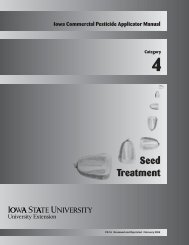Midwest Tree Fruit Spray Guide - Iowa State University Extension ...
Midwest Tree Fruit Spray Guide - Iowa State University Extension ...
Midwest Tree Fruit Spray Guide - Iowa State University Extension ...
You also want an ePaper? Increase the reach of your titles
YUMPU automatically turns print PDFs into web optimized ePapers that Google loves.
In the <strong>Midwest</strong>, two applications of Apogee at 10 to 12 oz<br />
per 100 gal should be sufficient for preventing fire blight<br />
spread in the summer, but overly vigorous trees may<br />
need a third application (see label).<br />
Additives. The nonionic surfactant Regulaid should be<br />
used with Apogee. Follow the manufacturer’s rate<br />
recommendations. If Apogee is applied in hard water<br />
(water that contains high levels of calcium carbonate),<br />
1 lb of spray-grade ammonium sulfate should be used<br />
for each pound of Apogee.<br />
Comments. Growth control with Apogee is not concentration<br />
dependent. There is no difference in shoot<br />
growth control between dilute and concentrate sprays,<br />
provided the total amount of chemical per acre is the<br />
same. The level of growth control with Apogee is rate<br />
dependent. The greatest and quickest reduction is<br />
obtained at the recommended rate, and the effect on<br />
growth declines as the rate is reduced.<br />
Insecticide Resistance in Codling Moth Populations<br />
Codling moth populations that are suspected or<br />
confirmed to be resistant to certain insecticides have<br />
been reported from several states, including those<br />
covered by this spray guide. The resistance traits of<br />
populations differ among orchards and regions, so<br />
resistance may account for control failures in some<br />
orchards even though the same insecticides may<br />
provide effective control at another location.<br />
Resistance is not the only cause for control failures,<br />
so growers are always urged to consider whether<br />
or not inadequate rates, inadequate spray volume,<br />
spray timing, or wash-off due to rainfall may have<br />
contributed to poor control. Where these factors do<br />
not appear to provide an explanation for control failures,<br />
then resistance, particularly to the organophosphates<br />
(Guthion, Imidan, Diazinon), may be the reason, and<br />
switching to other insecticides is recommended.<br />
Where control programs have been effective and<br />
resistance does not seem to be a problem, rotating<br />
among insecticides with different modes of action is<br />
recommended to delay development of resistance.<br />
(See mode of action groups on page 19.)<br />
Populations that are resistant to the organophosphates<br />
exhibit resistance to all the organophosphates that are<br />
labeled for codling moth control in apples (Diazinon,<br />
Imidan, and Guthion), so switching among these<br />
insecticides offers no benefit. Laboratory research and<br />
field observations have shown that organophosphateresistant<br />
codling moth populations also are less<br />
susceptible to some pyrethroids, so switching to Pounce<br />
(or other permethrin formulations), Asana, Warrior,<br />
Dantol, Baythroid, or Proaxis may not provide adequate<br />
control. The neonicotinoids Assail, Calypso, and Clutch,<br />
as well as the insect growth regulator Rimon, are<br />
effective against organophosphate-resistant codling<br />
moth populations. Growers are urged to consult with<br />
their state extension specialists in entomology to plan<br />
effective season-long programs that make the best use<br />
of available products within the label-specified limits and<br />
restrictions for each.<br />
Mating Disruption for Codling Moth Control<br />
Isomate C-Plus, No-Mate CM, and CheckMate CM<br />
dispensers are registered for control of codling moth.<br />
They dispense the sex attractant of the codling moth<br />
and are designed to prevent male moths from locating<br />
females for mating. <strong>Spray</strong>able formulations also are<br />
available. This strategy, termed mating disruption, is<br />
most likely to succeed in blocks of at least 5 acres where<br />
initial populations of codling moth are low. If mating<br />
disruption is used for codling moth control in smaller<br />
blocks or where infestations are greater, border sprays,<br />
or at least one or two cover sprays, also will be necessary.<br />
Controlling codling moth by mating disruption<br />
will not control other insect pests that are controlled<br />
by cover sprays (plum curculio and apple maggots,<br />
for example).<br />
Apple Borers<br />
The dogwood borer and American plum borer are<br />
caterpillars that attack burrknot tissue on apple trunks.<br />
Flat-headed and round-headed apple borers are beetle<br />
larvae that attack tree trunks, often in association with<br />
mechanical or other injury or generally weakened trees.<br />
Any of these borers can be treated with Lorsban<br />
Advanced at a rate of 1.5 qt per 100 gallons of spray,<br />
Lorsban 50 W at a rate of 3 lb per acre or Lorsban 4E<br />
at a rate of 1.5 qt per 100 gallons of spray no later than<br />
28 days before harvest. For dogwood borer, the best<br />
insecticide timing is at peak egg hatch, which is in late<br />
June in the central <strong>Midwest</strong>. For American plum borer,<br />
the best timing is at petal fall. For flat-headed and<br />
round-headed apple borers, apply insecticide in the<br />
spring. Apply borer sprays to the lower 4 feet of the<br />
trunk and lower branches, soaking the bark. DO<br />
NOT apply Lorsban to the fruit or foliage. Only one<br />
application of Lorsban of any formulation is allowed<br />
each year. Do not use for borers if already used prebloom.<br />
Periodical Cicadas<br />
Periodical cicadas are orange to black, about 1 1 ⁄2 inches<br />
long, with black transparent wings, and appear from<br />
May to July. Annual or dog-day cicadas are larger, green<br />
to black, and appear each year from July to September.<br />
Ordinarily, annual cicadas do not cause much damage.<br />
Cicada males announce their presence to the voiceless<br />
females by making a continuous, high-pitched shrill<br />
sound. Vibrating membranes on the underside of the<br />
first abdominal segment produce the sound.<br />
The total life cycle of the periodical cicada takes either<br />
13 or 17 years. Otherwise, the two types have similar<br />
habits. The adult females lay eggs in rows in pockets that<br />
they cut in small branches and twigs of trees with their<br />
long, knife-like egg layer. Each female will make five to<br />
20 of these pockets, laying 24 to 28 eggs in two rows in<br />
each pocket. The eggs hatch in six or seven weeks; the<br />
21 MIDWEST FRUIT TREE SPRAY GUIDE




